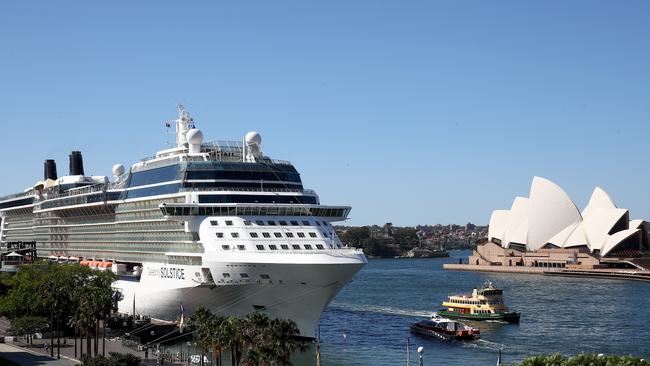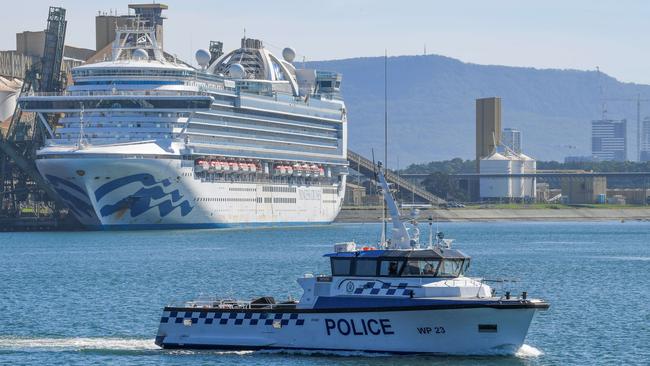Australian cruise passengers need negative COVID test result to travel
As NSW clocks up its 22nd with no community transmission of COVID, the cruise industry is coming up with strategies for keeping travellers safe at sea.
NSW
Don't miss out on the headlines from NSW. Followed categories will be added to My News.
As NSW clocks up its 22nd straight day with no community transmission of COVID on Sunday, the cruise industry is coming up with strategies for keeping travellers safe at sea.
Forcing all passengers and crew to return a negative COVID-19 test before they can board is the most dramatic of a raft of new safety measures the sector hopes will finally see cruising return by Christmas.
The Sunday Telegraph can exclusively reveal the tough new series of protocols — including daily temperature checks, a ban on self-service buffets and mandatory masks — that the industry believes will persuade the federal government to lift the ban on cruises.
The ban, which came in to place on March 18 — the same month infected passengers were permitted to disembark the Ruby Princess in Sydney — is set to expire on December 17.
Under the Biosecurity Determination, only ships with less than 100 passengers are permitted to enter Australian waters.
The Cruise Lines International Association (CLIA) Australasia has been working with the government on a phased resumption of domestic cruising in Australia, with a potential travel bubble with New Zealand and the South Pacific towards the middle of next year.

Other measures CLIA has proposed include operating at a reduced capacity to enable social distancing, quarantining of ships and crew on return to Australia, passenger health declarations for illnesses, contact history screening and regular on-board COVID testing.
Anyone who has been recently subject to any COVID-19 exposure restrictions or who has recently arrived in Australia will be banned from boarding.
Other measures mirror those in place at licensed venues and retail outlets such as the 4sq m per person capacities, sanitation stations, enhanced cleaning and directional markings in high foot traffic areas.
CLIA Australasia managing director Joel Katz said while restrictions imposed on other industries in Australia were slowly being lifted, the ban on cruising had remained.
Mr Katz said the industry had been devastated by the pandemic, with the Australian economy suffering an almost $2 billion loss from the suspension of cruise operations, with another $3 billion at risk should the ban continue into 2021.
Other businesses affected by the ban include travel agents, fresh food suppliers, tour operators, hotels, bus companies, baggage handlers and entertainers, he said.
The association has been in discussions with both federal and state government agencies on the pathway out of the ban.
“We have a long history in cruising in Australia and we are proposing a phased measured approach for cruising to resume in the country safely,” Mr Katz said.
“In the COVID world, we see a much bigger appetite for domestic cruising, but we may be able to open a bubble such as with New Zealand or the South Pacific — we are having discussions with those governments as well.
“We’ve done a lot of surveys of past passengers who are keen to cruise again. There is an expectations things will change on board. But the indication is that they will be happy to comply.”
CLIA and the Australian Cruise Association (ACA) will this week release an Economic Impact Assessment report, showing the impact the pandemic has had on the $5.2 billion contribution and 18,000 jobs that the cruise industry contributes annually to the Australian economy.

It reveals a $500 million loss from March — when the ban was imposed — to July this year, rising to a $2 billion loss today.
NSW stands to lose the greatest share of economic benefit from cruising, having
received $2.9 billion in direct and indirect economic output in 2019-20 and 9387 jobs.
The accommodation sector will be one of the largest losers from the ongoing suspension,
having received $367 million from passenger spending, followed by the food and beverage sector, which accounted for almost $227 million of passenger spend.
ACA chief executive officer Jill Abel said passengers spent more than $1.1 billion
at over 1000 cruise ship visits made around Australia each year.
At the start or end of a cruise, international visitors spent an average $549
each per day, compared to domestic travellers’ $436 each per day.
“Australia’s success in stemming COVID-19 creates the opportunity for governments to confirm a pathway towards cruising’s revival — one that offers local cruises for locals only, while international borders remain closed, while supporting an economic recovery,” Ms Abel said.
In other parts of the world, the extensive new health protocols have led to the carefully controlled resumption of cruising.
Originally published as Australian cruise passengers need negative COVID test result to travel





